Protecting the Milwaukee River? Or Overreaching Zoning?
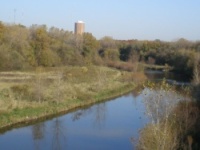
Milwaukee River
Over the past few years the Milwaukee River Work Group (“MRWG”) has pushed to create an overlay district to “protect” the Milwaukee River. This overlay district would create new building setback requirements, height limits, and introduce the concept of a viewshed for properties along the Milwaukee River. The River Revitalization Foundation’s website describes the overlay district as:
The Milwaukee River Work Group also proposes the creation of a small “buffer” area adjacent to the top of the “green” river bluff, which would create a special zoning district where design guidelines would have to be adhered to for NEW, multi-lot development (existing uses and structures “grandfathered”).
Although this overlay district is described as “small,” the truth is the combination of the setback requirement and height restrictions will eliminate significant amounts of developable land within the City of Milwaukee. The 50 foot setback sometimes is larger than 50 feet because it isn’t measured from the bluff line as commonly thought but from the drip line, which is where rain water drips from the edge of the tree leaves along the bluff. Additionally, in some cases this 50 foot setback would eat up about half of a lot, making development of the property nearly impossible. Further, by severely limiting new development this proposal actually encourages leaving abandoned or damaged buildings along the edges of the corridor.
To be clear, the purpose of these requirements aren’t to protect the river. The purpose of these requirements are to create a viewshed. Essentially, by restricting the height of buildings and siting buildings further away from the bluff they can be hidden from view. In this case it isn’t truly possible as various buildings are already visible from the primary environmental corridor, but arguably this may or may not be a desirable feature. That said, it has nothing to do with protecting the water, reducing CO2 emissions, or energy conservation and everything to do with protecting a view. In fact, these requirements fly in the face of environmentalism because by limiting development within the city it encourages more automobile use and promotes energy inefficient, low density development.
If the true intent of the overly district is to protect the primary environmental corridor, then the viewshed should not be a part of the overlay district. One potential solution that would protect the Milwaukee River and avoid these legal, environmental, and growth issues would be to stop development at the drip line. This approach would maintain the primary environmental corridor, protect the trees’ root systems and insure the integrity of the bluff. While at the same time it would allow for new development and the creation of density within the City of Milwaukee, both of which are economically and environmentally desirable goals.



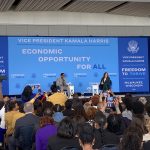

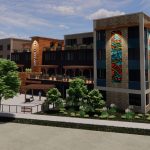
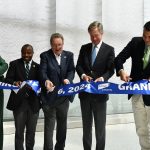

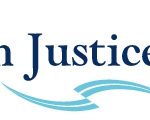


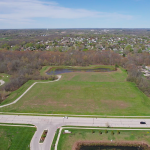





Is any specific property owner complaining about the 50′ setback? If that is a resident interest that truly exists, it hasn’t been heard yet. What has been heard are residents who simply want to minimize the likelihood of new development in this area because they want it as public and as green as possible, or (most often) they don’t want more neighbors, and they especially fear students and “yuppies.”
Barring any other input from residents, it makes sense for their sense of self-interest to carry some weight. In its reasonable form I think that self-interest boils down to not wanting any development (likely condos) on the bluffs. I personally agree with that. A lot of people enjoy walking and biking through that corridor and being surrounded by green. It’s nice to have that in the city–it’s rare, and once it’s gone, it’s gone for good.
It’s hard to describe what this is that’s at stake. It’s prone to being misdescribed in terms that suggest the built environment is inherently bad, and undeveloped, uncultivated land is inherently good in some strange projection of moral values on the landscape to which nature is indifferent. That’s not it.
The unreasonable forms of support for maximum restriction on development include this weirdly moralized hostility toward the built environment by people who nevertheless live in it, as well as the presumption that new development will bring students and yuppies, who are also likewise moralized as bad actors.
The presumption that students are, on the whole, a rowdy addition to a neighborhood is approximately correct, if we are talking about apartments and duplexes. Dorms–and rather segregated ones at that–have not been appreciated as a good container to keep a lid on rowdiness. The presumption about condos and yuppies is harder to explain
The presumption that condos bring yuppies who are rich capitalist snobs is harder to account for. The idea seems to be that these people will ruin Riverwest’s mythical bohemian mojo, run up property values, and make residents with food service jobs, government jobs, non-profit jobs, or no jobs feel small and threatened. The people who spend the most time worrying about Riverwest and polishing it up as a brand that can confer coolness on them seem to fit in these categories, along with numerous “young urban professionals” who like to affect a disaffected, sub-mainstream identity and therefore rent or buy homes in Riverwest.
Keeping up a running battle with “gentrification” continues to be vital to many Riverwest narcissists’ need for a sense of identity, belonging, and noble struggle against a cruel, cruel world. The best thing for them is to be ignored until they decide to engage reality and grow up.
On second thought I would say the natural environment is not indifferent to what you do to it, as if there are no consequences; what nature is indifferent to is how you feel about the view and trees and all that. It’s important to people, but if nature has an interest, it is largely material and mechanical–what can grow in a place, if anything, and can rainwater flow to the river without erosion and mudslides.
Development that messes up the drainage or causes erosion or harms ecosystems by displacing plants and animals with buildings, paths, roads, and traffic might also create a view some people don’t like, but it is more legitimate to value protection of these other natural systems because they are healthy, like plumbing that works right. They’re also attractive, as opposed to ugly, which is an indicator of health and not an end in itself. It’s good there is concern and effort organized to protect these natural systems.
At the same time the built environment and the human community has its own economy with its own needs and interests, so it would be good to be able to consider them along with the natural environment as equally legitimate rather than simplify it as development bad, wildness good. That was what I was trying to get at.
Other than the issues raised by the North Ave. BID about the setback are there other areas along the corridor where people are getting concerned about the setback requirements dropping of their property values? My impression has been that along the west bank, existing residents don’t want new development there even if it means rising property values, which some people see as a bad thing, or just not an adequate compensation for increased density and traffic. I’m not sure we care enough about the different way people look at “property” when they are settled and have no intention of moving. That is what knits a neighborhood an community. At the other extreme are speculators and property flippers, who may make realtors and assessors happy, but we’ve seen the harm that does when it gets out of control. Excess commodification of land and houses does threaten the communal dream of the good life.
Doesn’t ReadCo still own some land (on the old rail corridor) along the bluffs north of Rivervview? If there are development interests there, they are going to face opposition to some of the things they could do with less restrictive zoning, and if there is a matter of fairness in this, I think it’s fair for the people in that area to have some say in what can be done or not done with one’s individual property rights, like it or not. If residents want an all-out ban for all intents and purposes on new development, maybe that is a bit prohibitive, and maybe they can or can’t get it, but fighting it out through public processes over zonign and what have you is the way we handle that. Everyone doesn’t get what they want, but that’s life.
Setting restrictions on height and setback requirements seem like minimally restrictive ways to give developers some parameters they can work with and still satisfy the interest of minimizing the ecological footprint of new construction. If there was no such environmental interest, I doubt developers would be bothering to think creatively about design and the ways the natural and the artificial can best coexist.
We have all seen what development in urban cities is like, after all we are talking about Milwaukee here. What is going to be accomplished here is a protected natural area in the city that feels like a protected natural area. Why is it that we need to develop this land like the rest of the urban landscape? Why is it that this land can’t be valued by the people that live in this community the way they see fit? Why is it that new development can’t find new ways of sustaining instead of the old ways of building with no foresight? We need to hold on to what we have now, with no compromises, and find new solutions to age old problems.
Finally, it would be hard to argue that these new requirements would do much to help protect the environment, rather this is a symbiosis with the environment and the health of the people living here. Yes, I believe it is true that a more natural environment helps maintain a proper and healthy mental state of mind for many people. Some people like to look at buildings, but I prefer to gaze upon trees and animals, and the unspoiled horizon that takes me away from the city when I need to recharge. I want new ideas, not old ones.
@Jason
“What is going to be accomplished here is a protected natural area in the city that feels like a protected natural area. ”
No what will be accomplished is protecting the “view”. Allowing building up to the dripline (the actual environmental corridor) will
1 Protect the environment
2 Maintain a significant amount of urban land for development
3 Not trample on owners rights
4 And actually be environmentally friendly
“Why is it that this land can’t be valued by the people that live in this community the way they see fit? ”
What about the property owners? Do they get a say? I live in Milwaukee, the community, and I believe for the reasons stated above this is a bad idea.
“We need to hold on to what we have now, with no compromises, and find new solutions to age old problems.”
I guess I’ve always thought compromises were good.
Further the question that always jumps out in my mind is say two blocks from the river a developer wants to build a 20-story building that will now be seen by people walking along the river should that be stopped? Even if it is outside of the overlay but clearly could be seen? Where does it end?
@Dave
“No what will be accomplished is protecting the “view”.”
I agree with you and this is what I am talking about when I say it will feel like a protected natural area. Has anyone ever gone off into wilderness for personal reflection to come across some 50 foot buildings and parking lots? If so, would this “feel” like a protected natural area or would it “feel” like an urban area in the midst of wilderness? What we’re talking about here is trying to preserve the “wilderness” in the midst of an urban environment and that this has value to people.
“What about the property owners? Do they get a say? I live in Milwaukee, the community, and I believe for the reasons stated above this is a bad idea.”
No, a bad idea is treating land like “property” where only the owners can determine its fate. I think the community should have a say in how the community should look and feel. If you have property along the corridor, then by right you have an argument as to how it should be developed. Because we live in a democratic society, all of us in this community also have a say as to how it should be developed.
“Further the question that always jumps out in my mind is say two blocks from the river a developer wants to build a 20-story building that will now be seen by people walking along the river should that be stopped? Even if it is outside of the overlay but clearly could be seen? Where does it end?”
This is a good point and maybe it should be addressed. However, seeing the opposition that the MRWG has already faced thus far, I believe that there is likely is an end.
@Dave: a 20-storey building built outside the overlay but visible from the center of the river (which is how the viewshed is determined) is not subject to the overlay’s restrictions, right? People might not like it, but they’d have to find a way within the zoning politics to stop it. Unless you are talking about sites toward the north end around Capitol Dr. or north of it to the city limits, wouldn’t it be hard to impossible to build something that high and dense based on “neighborhood appropriateness” criteria (comparable scale) and certain resident objections to that effect?
@Jason: from what I’ve seen, the language used in connection with the corridor’s purpose has NOT been John Muir style radical “wilderness” preservation–which would actually entail keeping people out period. Instead New York City’s central park has been used as a comparison. Wilerness means not just no development, but few or no people, no trails, certainly no paved trails. That is not what exists here, nor is there any suggestion of that as an intention from what I’ve seen. Given the population level surrounding the area and the increasing pathway access, this is absolutely not a wilderness area. These words must also have some legal and legislative basis. Look at the actual text of the overlay and see if it says anything about pristine wilderness preservation.
Similarly on property rights: you may dislike them, but that is neither here nor there. The law is the law. Your idea of “democracy” meaning that I have as much or even 10% as much as your say on what you do with YOUR property within relevant legal constraints is simply not how things work. It really has nothing to do with “democracy” either, which in any case has nothing to do with the representative system we have.
@Dan yea where exactly that hypothetical building would be proposed but the point is this could help future fights to stop that building. I know it would be brought up and argued for sure. Or how about this a 5-story redevelopment of the Jewel (Pick & Save now), which I think is outside of the overlay, would likely be visible from the river while at the same time not be out of character with the other buildings in the neighborhood.
Anyhow the point is this overlay goes beyond trying to protect the river and attempts to protect a view, at some cost to the City of Milwaukee, property owners, and the environment.
@Dan
“Given the population level surrounding the area and the increasing pathway access, this is absolutely not a wilderness area.”
I couldn’t agree more and my use of the word “wilderness” is more the idea of nature and less what John Muir may have intimated in his writings. Nevertheless, I believe it is important to protect that idea and to strive towards as “wild” or “natural” a setting we can achieve in the urban landscape. If John Muir wanted to keep people out entirely, it was rather hypocritical of him to think that it was OK for him to be excluded.
“It really has nothing to do with “democracy” either, which in any case has nothing to do with the representative system we have.”
I entirely disagree. After all, zoning regulations are created by people who serve the public. If zoning regulations are not subject to change and were not created within our democratic institution, then you are correct. However, zoning regulations are changed and in many cases it happens to be the result of democracy in action – people voicing their opinions and getting the rules changed. I fail to see how that has nothing to do with the representative system we have.
All bickering over the details aside, what we’re talking about here is a grassroots movement that is trying to protect what they believe is worth protecting. It is obvious that not everyone shares the same sense of worth, but I strongly believe trying to protect a sense of nature in this oftentimes hostile environment is invaluable.
Jason, What is the “grassroots movement?” MRWG? I guess if “grassroots movement” means a movement that is directed and managed by select people and groups who are paid to do what they do, allowing whatever public input they allow, but it’s not like riverside residents came up with the overlay and are the main ones pushing it. The people principally involved seem to live well outside the overlay.
A directly democratic and “grassroots decision” on the overlay would turn the matter over to a deciding vote by people within its area and/or contiguous areas up to a certain distance–why not the whole city or county if you want to be really inclusive. There is county land down there after all.
Since this is not the way things get done, that is why I said the issue nothing to do with democracy. You seemed to be describing “democracy” as giving the maximum people the maximum influence in making a decision determining an outcome. That would mean a scenario like the one I’ve described here–direct democracy, with direct voting, the public decides. I’m not sure if you think that would be better or if the representative system we have is fine or not.
It sounded to me like you want power shifted to some segments of the public somehow with the idea that property owners have too much control over their property, and if their neighbors want to exercise control over that property–especially for the purposes of totally stopping any development–they should be able to do so. The only way you could currently get that outcome is by getting enough aldermen to use the zoning code primarily to frustrate the intentions of property owners as much as possible. This would never curtail development absolutely, however, which is a totally unjust and ridiculous goal. Why should a private owner hold property and pay taxes on it without the ability to do anything but cut the grass? Where this level of preservation is wanted by enough people, the right thing to do is for the public to buy the land from the owner at a price the owner will accept.
Land IS property, and its owners (public or private) are the main one to “determine its fate” by right. The community does “have a say” in some things, to the extent that the law and municipal process allows. The county buying more parkland at this point is a hard sell, and only completely idiotic aldermen would focus their efforts on thwarting development just because it is new development some residents dislike–particularly at this time when the collective interests of the city and the larger environment center on urban growth. Should the city push developers into adding to suburban sprawl?
We have failing infrastructure, declining services, high and increasing taxes, and the prospect of real estate being assessed higher than its market value. The Milwaukee River Greenway is green and will remain pretty darn green even with tall buildings along its edges. To focus on demands for more, and a presumptive hostility toward development in the wealthiest and whitest part of the city is the height of myopia and selfishness, not to mention a recipe for backward steps for the city so a few people can have their sanctuary and solace, pretending there are no buildings or people around them, down in the river valley. Like I said before, I have sympathy for that, and I think accommodations ought to be made where possible, but the value of a river “sanctuary” defined mainly by a view clear of buildings rather than material considerations (economic and environmental) is terrible.
I can’t stress the selfishiness and narrow-mindedness of this enough. Here is how it’s been manifested by east siders and some riverwesters:
-Don’t build a footbridge across the river, it will bring in crime from the west.
-Build those dorms west of Holton, maybe along King Drive. *They* need the development there.
-Keep our property values and taxes down, but build us a big public park.
All I hear in that is selfish people with a false, not to mention classist and borderline racist notion of communal interests and obligations that they manipulate rhetorically to support their own individual, faux-progressive bourgeois interests.
@Dan
It stands to reason from your comments that you have no regard for the people of this community (Riverwest and the East side) and that you value development over green space. The goals of the work group are not to stop development and that’s not what I have been talking about. I’ve been talking about holding on the the remaining vestiges of what this corridor used to be. So it sounds like “pretty darn green” is good enough for you and my argument is that it isn’t good enough for some people.
There are obviously more than a “few” people that use this corridor and I don’t think it is ridiculous to ask that development along sensitive areas be different from development in the rest of the city. As I said, I think the development in and around Milwaukee has not been properly thought out. This is the case with most, if not all of the major cities in America.
The problems that you refer to with taxes, infrastructure, and services is certainly not unique to this area surrounding the corridor, this city, or other cities with sufficient development so allowing unrestricted development is not going to solve the problem as much as you wish to think it might. Our leaders need to come up with creative ideas to solve these problems and changing the development restrictions along this very small strip of Milwaukee is not going to have a profound impact on those problems.
Jason, I don’t value “development” or “greenspace” in themselves, just because they are “development” or “green space.” It is a mistake to regard them as opposites, or either-or choices, especially in a city. Beyond simple use as shorthand terms, they get to be unhelpful.
I think you’ve totally missed the points I’ve been making about not going too far in either direction, or simply not making bad choices, which can also happen when you are leaning in a preservationist/conservationist direction. I never said the river shouldn’t get special protections, and I didn’t say that the city’s financial needs and the public’s needs for city services should mean unrestricted development. The topic here originally was about the 50′ setback rule in the overlay, not whether there should be an overlay/any restrictions at all.
Are you speaking for “some people” or all “the people of the community” now? I’m not speaking for anyone but myself. Who are these hypothetical people you say “I have no regard for?” Are you saying I shouldn’t so much as post an opinion in a blog comment without checking first for conformity to the prevailing opinion of your “people?” And why do you assume that “the community of relevant opinion” on public (city and/or county) land means “Riverwest and the East Side?” People on King Drive live closer to the river than some East Siders.
@Dan
I won’t and haven’t narrowed the scope of the “community of relevant opinion” to just Riverwest or the East Side, rather that seems to be how you have approached the argument. These are the hypothetical people that I say you have no regard for from your prior post:
“I can’t stress the selfishiness and narrow-mindedness of this enough. Here is how it’s been manifested by east siders and some riverwesters:
-Don’t build a footbridge across the river, it will bring in crime from the west.
-Build those dorms west of Holton, maybe along King Drive. *They* need the development there.
-Keep our property values and taxes down, but build us a big public park.
All I hear in that is selfish people with a false, not to mention classist and borderline racist notion of communal interests and obligations that they manipulate rhetorically to support their own individual, faux-progressive bourgeois interests.”
Maybe you could further clarify what you meant by this comment, but it does not matter to me. I have made my point that I think there is value in maintaining this strip of land the way it exists now and for the people that use this land to feel like it is still a bit “wild” and untainted – even though that may not entirely be true. BUT, it is important for people to enjoy the outdoors and when they are staring at buildings, it very much changes the way that the mind perceives the natural world and tarnishes their experience. For many people that live in and around this community, this corridor provides the opportunity to enjoy green space for people that may not be able to afford traveling to other areas.
Your argument that these people are wealthy, rich white folk is also ridiculous especially if you have spent any time on the trails along the river. People from all socio-economic backgrounds enjoy this corridor. Development can continue, but why does it have to continue in such a way that impedes the enjoyment of this green space? There are ways for development to occur along the corridor, why can’t we be more mindful? Why? I still don’t get it. Why?
What precedent will protecting the viewshed have? Could it be used to prevent development in other area’s of the city because people in those neighborhoods want their views protected. What about condo owners who object to another tower going up across the street because they don’t want their view blocked. Couldn’t he make the argument that his view is just as important as the view for those on the east side, and it should be protected also. Will the precedent of protecting views allow for them to stop the development. Or perhaps this will set a precedent around all the parks in the city that limit heights near them to protect the views? What could the legal impact of creating a binding limit on heights for the sole reason of protecting vSeiews have on the city? If the MRWG wants to protect the greenspace then they need to acquire the property they don’t want developed.
Secondly, I think that if they are going to try to claim they want to create a ‘central park’ in Milwaukee they should look at what makes central park so successful. Central Park is about people, it has towers all the way around it so that it can maximize the views of the park for the most # of people. Compare the number of people with views who live in a 5 story building to that of the number of people living in a 25 story building, the 25 story building has 5 times the number of people with a view. Why not provide the most benefit to the maximum number of people by removing any height limits next to the river, so that building around the green space can be as tall as financially possible, and so the green space can benefit more people. By creating a height limit, you are limiting the number of people who can benefit from the green space, and are being selfish.
@matthew
I think Matthew hits the nail right on the head with his comments here. The opponents of the proposed new regulations for this area benefit from this land because of the value associated with having a view of the river valley. By allowing development of condos and high rise apartments along the corridor, the city is catering to the wealthy and taking away from the lower class. While the upper class who will live and work in the high rise buildings along the river will benefit from the view of the valley, the lower class who will not be able to afford a place with a view of the river and those who actually recreate in the area will suffer from the urbanization of the corridor.
If development along the corridor occurs sensibly, people in the future will be thankful for Central Park – high rise buildings and increased density can occur in other areas that are not so sensitive. They can enjoy Central Park as well, they will just have to get out of their house/apartment to enjoy it.
Jason,
Yes I don’t think there is a lot of credibility from people who are just focused on NIMBY issues where they fear crime and disturbances from any new development in their area. They’re not really interested in the economics or the environment. That is unfortunately where a lot of the typical vocal opinion comes from on 3rd district development issues. I also don’t think that it’s credible to be concerned merely with “views” or to see “development” as always and necessarily incompatible/hostile to environmental concerns.
Yes lots of different people enjoy the river corridor. Some get very territorial about it. I know several people who have a proprietary attitude toward that whole area. Some don’t want more people coming in or nearby period. Some are specifically annoyed with “yuppies” coming on “their” trails. Others seem to be overly fearful of a criminal element they feel may suddenly swarm into a more accessible river corridor. A general concern with overuse is reasonable, but this is more typically what I’ve heard–specific prejudices toward specific “outsiders” who do not belong in “my” (public?) space. I don’t think that’s right at all.
I think the new development in the era of the overlay has been mindful so far of preserving the natural environment and its systems. I don’t see a threat on the horizon that will impede the health or enjoyment of that area. The issue about the setback seems to be mainly one of not unduly inhibiting privately property rights when there is no environmental reason to do so.
@Matthew: I think you’d have a hard time creating another viewshed restriction somewhere else unless it was a similar river valley scenario. The view being protected is the view from the river, from the public land area, which is occupied only by plants and animals.
MRWG doesn’t need to acquire any land if they follow their plan of getting agreements with the owners of the public and private land segments along the river, and if the overlay works as intended. I don;t know if a public land trust holding the entire area is something anyone has looked at, but I doubt it is feasible or desired by anyone.
Massively tall buildings along the river north of the lower east side and even downtown would not be “neighborhood appropriate” design. The Commerce St. and other Riverwalk areas south of there could not be copied to the north without major public opposition, and I think that opposition would be right. Possible exception around the “blue hole” and Shorewood and Glendale.
Selfishness is not really the issue.
@Jason
I’m not sure how anyone would “suffer” if high rise buildings went up along the river outside of the primary environmental corridor. In fact both the “rich” and “poor” would be able to enjoy the river (Mathew points out that more people could enjoy it then, not less) and everyone would reap the benefits of density. Protecting the “view” while being nice at the expense of reducing density and limiting development options of property owners is well a very steep price to pay.
Again we keep referring to this as Milwaukee’s Central Park right? You can most definitely see high-rise buildings from Central Park in NYC and well it works.
I tend to agree with Dave’s last comment. The concept of limiting building height to protect the viewshed should be abandoned. Protection of the viewshed in that manner will limit development and attempt to simulate a rural environment in the middle of the city. That is not representative of a central city park. We should strive to protect the watershed, while maximizing utilization of the view, whether from a trail or a window. Remember, not everybody has the physical ability to walk, bike, run, paddle an urban river, but they still want to enjoy it.